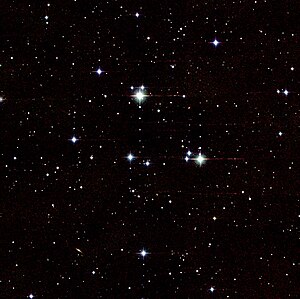 Praesepe: the open cluster Messier 44 (Photo credit: Wikipedia)
Praesepe: the open cluster Messier 44 (Photo credit: Wikipedia) Where’s my sign? Yes, I mean “where”, not “what”. I know I’m a Cancer – I know what my astrological sign is. I just didn’t know where to find it.
Actually, I’ve never really put any stock in Astrology as being any kind of guiding force in my life, but, from time to time, I have been somewhat interested in it as entertainment. I also have been reminded recently that, although they probably don’t really have any true effect on my existence, the astrological constellations (like all constellations) do provide a convenient way of mapping the night sky in order to find many other interesting objects that are out there.
I had never really tried to find the constellation, Cancer, in the heavens, but occasionally I have wondered what it really looks like and if it was associated with any other interesting cosmological phenomena.
So, while entertaining my rekindled interest in lay astronomy by investigating what might be interesting and fun to look for in the late March Aspen skies, I stumbled upon the following earthsky.org article: "Cancer? Here's your constellation" . It promised that 2012 was my year to “find it easily”. I was excited!
The article stated that although Cancer is the faintest of all 13 of the zodiacal constellations (yes, there really are 13, not just 12), this March would be a good time to find it due to its proximity to Mars. Since I am now a pro at finding the naked eye planets in the Aspen skies , including Mars, I thought I would give it a try.
While waiting for the weather to clear up enough to have a good view of the night sky, I had time to learn a bit more about “my” constellation. I discovered that, although it does not have the notoriety of some of the more conspicuous zodiacal constellations, like Leo, Virgo, or Gemini, it does contain an interesting cosmological structure – an open cluster called the Beehive Cluster.
According to Wikipedia, an open cluster is “a group of up to a few thousand stars that were formed from the same giant molecular cloud and have roughly the same age.” Open clusters are useful to cosmologists due to their similar ages and compositions. This aids scientists in their study of stellar evolution.
The Beehive Cluster is one of the closest open clusters to our solar system. It also contains more stars than most other nearby clusters, and was one of the first objects to catch the attention of Galileo as he studied the night skies ( http://en.wikipedia.org/wiki/Beehive_Cluster#cite_note-Messier44-1).
Cancer also contains another cluster, Messier 67. This is thought to be the area of the galaxy from which our sun originated - http://earthsky.org/constellations/cancer-heres-your-constellation.
Cancer as a constellation has mythological/astrological significance as well. In ancient times the Beehive Cluster was thought to have marked the “Gate of Men”, which was believed to be the “portal that souls descend from the heavens above and into the bodies of the newly born” http://earthsky.org/constellations/cancer-heres-your-constellation .
Ok, my sign is more interesting than I thought, but I wanted to SEE it!
I got my chance the following night, after attending a very informative presentation about "Climate Change and Our Future in the Rocky Mountains" at the Aspen Center for Environmental Studies. I took advantage of being out of the higher light pollution areas to see if I could find my elusive constellation.
I found Orion hovering over Aspen Mountain and followed the “line” through the rightmost belt star and Betelgeuse to find Castor and Pollux of Gemini. I found Mars and then found Cancer in between.
It was still difficult to see and I actually could not quite make out the Beehive cluster, but I did see the constellation itself. I can finally answer the question, “Where’s my sign?"



